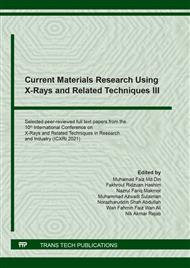[1]
R. L. Deuis, J. M. Yellup, and C. Subramanian, Metal-matrix composite coatings by PTA surfacing. Composites Science and Technology, (1998). 58: pp.299-309.
DOI: 10.1016/s0266-3538(97)00131-0
Google Scholar
[2]
J. T. Wang and M. D. Jean, Optimisation of cobalt-based hardfacing in carbon steel using the fuzzy analysis for the robust design. International Journal Advance Manufacturing Technology, (2006). 28: pp.909-918.
DOI: 10.1007/s00170-004-2123-6
Google Scholar
[3]
A. S. C. M. D'Oliveira, R. Vilar, and C. G. Feder, High temperature behaviour of plasma transferred arc and laser Co-based alloy coatings. Applied Surface Science, (2002). 201-1-4: pp.154-160.
DOI: 10.1016/s0169-4332(02)00621-9
Google Scholar
[4]
A. S. C. M. D'Oliveira, J. J. Tigrinho, and R. R. Takeyama, Coating enrichment by carbide dissolution. Surface & Coating Technology, (2008). 202: pp.4660-4665.
DOI: 10.1016/j.surfcoat.2008.03.034
Google Scholar
[5]
S. Ilo, C. Just, E. Badisch, J. Wosik, and H. Danninger, Effects of interface formation kinetics on the microstructural properties of wear-resistant metal–matrix composites. Materials Science and Engineering: A, (2010). 527-23: pp.6378-6385.
DOI: 10.1016/j.msea.2010.06.060
Google Scholar
[6]
S. Zhang, S. Wang, C. L. Wu, C. H. Zhang, M. Guan, and J. Z. Tan, Cavitation erosion and erosion-corrosion resistance of austenitic stainless steel by plasma transferred arc welding. Engineering Failure Analysis, (2017). 76: pp.115-124.
DOI: 10.1016/j.engfailanal.2017.02.007
Google Scholar
[7]
R. Sundaramoorthy, S. X. Tong, D. Parekh, and C. Subramanian, Effect of matrix chemistry and WC types on the performance of Ni-WC based MMC overlays deposited by plasma transferred arc (PTA) welding. Wear, (2017). 376-377: pp.1720-1727.
DOI: 10.1016/j.wear.2017.01.027
Google Scholar
[8]
C. P. Paul, S. K. Mishra, P. Tiwari, and L. M. Kukreja, Solid-Particle Erosion Behaviour of WC/Ni Composite Clad layers with Different Contents of WC Particles. Optics & Laser Technology, (2013). 50: pp.155-162.
DOI: 10.1016/j.optlastec.2013.03.002
Google Scholar
[9]
L. Mao, M. Cai, Q. Liu, and L. Han, Effects of spherical WC powders on the erosion behavior of WC-Ni hardfacing used for steel body drill bit. Surface and Coatings Technology, (2021). 409: p.126893.
DOI: 10.1016/j.surfcoat.2021.126893
Google Scholar
[10]
S. Sharma, Wear study of Ni–WC composite coating modified with CeO2. The International Journal of Advanced Manufacturing Technology, (2012). 61-9: pp.889-900.
DOI: 10.1007/s00170-011-3764-x
Google Scholar
[11]
Y. Hou, H. Chen, Q. Cheng, L. Fan, and L. Dong, Effects of Y2O3 on the microstructure and wear resistance of WC/Ni composite coatings fabricated by plasma transferred arc. Materials Express, (2020). 10-5: pp.634-639.
DOI: 10.1166/mex.2020.1686
Google Scholar
[12]
P. Farahmand and R. Kovacevic, Corrosion and wear behavior of laser cladded Ni–WC coatings. Surface and Coatings Technology, (2015). 276: pp.121-135.
DOI: 10.1016/j.surfcoat.2015.06.039
Google Scholar
[13]
S.-s. Liu, H.-y. Chen, X. Zhao, L. Fan, X.-m. Guo, and Y.-s. Yin, Corrosion behavior of Ni-based coating containing spherical tungsten carbides in hydrochloric acid solution. Journal of Iron and Steel Research International, (2019). 26-2: pp.191-199.
DOI: 10.1007/s42243-019-00240-y
Google Scholar
[14]
G. Inzelt, Standard, Formal, and Other Characteristic Potentials of Selected Electrode Reactions, in Encyclopedia of Electrochemistry, A.J. Bard, Editor. (2006), Willey John & Sons. pp.34-54.
DOI: 10.1002/9783527610426.bard070002
Google Scholar
[15]
D. Kesavan and M. Kamaraj, Influence of aging treatment on microstructure, wear and corrosion behavior of a nickel base hardfaced coating. Wear, (2011). 272-1: pp.7-17.
DOI: 10.1016/j.wear.2011.05.041
Google Scholar
[16]
M. Jones and U. Waag, The influence of carbide dissolution on the erosion–corrosion properties of cast tungsten carbide/Ni-based PTAW overlays. Wear, (2011). 271-9: pp.1314-1324.
DOI: 10.1016/j.wear.2011.01.046
Google Scholar


